
Wine Culture and Information since 2002 - Volume 22
 Wine Culture and Information since 2002 - Volume 22 |
|
Issue 140, May 2015 |
Contents |
|
|
DiWineTaste Wine Guide: Five Thousand! |
|
I have always considered DiWineTaste a project in progress. From the initial idea of 2000 - that is creating an independent publication about wine culture and critics, becoming reality in 2002 with the publication of the first issue - DiWineTaste has walked a quite long way. It was too easy to understand that initial idea - which had no pretension to be final - has changed over time, by adapting to new ideas and times, even by adopting the suggestions of our readers. From that initial idea, today exist - like to say - the fundamental pillars which have always characterized DiWineTaste, to which we added many others. The initial spirit has never changed: my will to promote the culture of wine has always had the priority over every choice. I am not going to tell or believe this goal has been achieved or honored: I am perfectly aware of the fact every goal is just a new beginning. One of the elements characterizing DiWineTaste since the beginning of its journey is the Wine Guide. To that have been added, in the following years, Aquavitae - our Distillate Guide - and Wine Place Guide. Tools being very appreciated by our readers, something of which we are certainly very glad of. The availability of our two apps for Android and iOS has also contributed to the frequency of use of our Guides, in particular in the evening and night. A tool like the app allows, in fact, to use our Guides even when you are on the go, for example when you are at a restaurant or a wine shop. In particular, Wine Guide - which is capable of suggesting a pairing for a wine by simply entering a dish or its ingredients - records a substantial number of accesses in the evening and at night.
Two months ago our Wine Giude has achieved a goal we consider to be important. Last March 2015 our Wine Guide has in fact reached the goal of reviewing five thousand wines, a job we did in the course of our “almost thirteen” years of activity. Every wine has been strictly tasted by using the evaluation method called “blind tasting”, that is without revealing to the taster the characteristics of the wine. Five thousand wines in almost thirteen years, allowed us to suggest every day to our readers at least one wine, by providing sensorial characteristics and food pairing. It is not about self celebration, something I generally dislike: it is the simple statement of what we did, in this sense, with our Wine Guide. The will to suggest at least a wine every day to our readers is, moreover, essential for the dedicated section found in DiWineTaste home page. During this “almost thirteen” years - to be precise, we will celebrate the beginning of our fourteenth year the next September 2015 - our Wine Guide has changed quite a lot in regard of the initial version. To tell the truth, when the first issue of DiWineTaste was published - 9 September 2002 - the Wine Guide was not even part of the initial project. Three months later we realized the job done with our tasting and reviews deserved a dedicated place, in order to keep track of what have been poured in our glasses. Our Guide is not “seasonal”: it is a chronological directory of our tasting activity. This type of organization allows, among the other things, to evaluate the qualitative trend of a wine over vintages, by using our scoring system consisting in diamonds and stars. Something well known by our readers, scores are expressed from one to five diamonds; star is given to those wines considered to be excellent in their category. Our Wine Guide has been officially released on January 1st, 2003. At those times, just after four months of DiWineTaste activity, we reviewed a little more than fifty wines. Thirteen years later that number increased one hundred times, therefore reaching five thousand wines singularly tasted and reviewed by using the “blind tasting” technique. Our goal has always been to suggest to our readers at least one wine daily, therefore in DiWineTaste are being tasted and reviewed more than thirty wines each month in order to achieve this goal. In the following years, our Wine Guide has been integrated to our Wine Place Guide, our directory of restaurants, wine shops and business related to wine. In order to allow our readers a better interaction with our publication, it is now a long time they are allowed to publish their comment and opinions about the wines we review. The reviews of our readers are part of our Guide and published in the page of the respective wines. The release of our app DiWineTaste Mobile for Android and iOS allowed new ways about using our Guides, including the Wine Guide. The last update is about the graphical aspect of the pages dedicated to wines, by replacing the old and totally descriptive layout in favor of a more practical and immediate division according to each phase of tasting. New wine pages show in fact, since some months, small icons associated to appearance, smell, taste, overall and wine making aspects about each wine. The old pages, at least for the moment, will keep their old style and, time will tell, a day we could also update them in order to show the new graphical style. Five thousand wines represent for us an important goal. We are however aware of the fact this is not an impressive number, nevertheless, it is not frivolous as well, it tells, as a matter of fact, the total commitment and passion we dedicated to wine in thirteen years. Ready to continue our journey, always having the nose smelling what a glass can give. Antonello Biancalana
|
||||||||||||
Contrasts of Marsala Vergine and Vernaccia di OristanoThe two great wines of Sicily and Sardinia compared one to each other: two different grapes and expressions however having many elements in common |
|
Sicily and Sardinia are the largest islands of Italy. Great islands not only for their area but also for the natural beauties, history, monuments and art, as well as for the rich cuisine and great wines. Whites, reds and sweets - including some good bubbles as well - Sicily and Sardinia offer a viticultural and wine making richness of primary importance. Moreover, the two islands are famous for the production of ancient wines of noble prestige: Marsala in Sicily, Vernaccia di Oristano in Sardinia. Wines which lived alternate moments of glory and oblivion, in recent times - thanks to the revaluation and the precious job done by some producers - Marsala and Vernaccia di Oristano are expressing unique and inimitable qualities again. Considered by many as wines having an ancient taste, these two giants from Sicily and Sardinia represent a sensorial exercise of remarkable complexity, as well as of undeniably pleasure. Ancient wines and, in the best interpretations, rare and prestigious, Marsala Vergine and Vernaccia di Oristano are produced with pretty particular wine making techniques. One of them consist in favoring oxidation of wine, something strictly avoided and considered negative for table wines. Indeed, Marsala Vergine and Vernaccia di Oristano make of oxidation one of their main peculiarities, by even elevating oxidation to a noble quality. It should be said these two wines are not just oxidation. The world of Marsala and Vernaccia di Oristano - as well as all the other wines produced with the same techniques - is rich and complex, nevertheless, wonderfully pleasing. A complexity which can be appreciated at every phase of the tasting, from appearance to taste, capable of giving unrepeatable and rare qualities like no other wine. The history of Marsala is fascinating and amazing, a characteristic it certainly has in common with all the historical fortified wines produced in Europe. A history having as protagonists English and Italian merchants, sometimes challenging each other about the richness of their wineries or, like they would say in Sicily, of their baglio. Marsala is in province of Trapani and since ancient times it has played a fundamental role in the commercial and trading activities of Sicily. Marsala was famous for its harbor, which probably was what originated its name. It was in fact Arabs to name the city Marsa Ali - that is “Ali's harbor” - or Marsa Aliyy, which meaning is “big harbor”. The lovely Sicilian city has lived the commercial fate of the wine produced by Woodhose, Ingham, Whitaker and Florio families, to which have been later joined those of Rallo, Curatolo Arini and Pellegrino. The names of some of these families are still today found in some bottles of Marsala wine.
Marsala, after the many revisions done on its production disciplinary, is currently produced in the following styles: fine, superiore, superiore riserva, vergine or soleras, vergine riserva or soleras riserva, vergine stravecchio or soleras stravecchio and rubino. Grapes used for “white” Marsala are Grillo, Catarratto, Inzolia and Damaschino, however it should be noticed that, of these varieties, Grillo is considered to be the noblest of them all. Marsala Rubino is produced with Perricone, Nero d'Avola and Nerello Mascalese. The production of certain Marsala styles provides for the adding of mosto cotto (cooked must), concentrated must or sifone (mistelle), in order to get different colors and sweetness. Marsala Vergine is the only style in which it is not allowed the adding of anything in order to change both color and sweetness. In all Marsala styles is done fortification, that is the adding of wine brandy, something increasing the alcohol by volume of the wine. Sardinia, a land rich of excellent wines, is also the homeland of Vernaccia di Oristano. This precious wine is sometimes considered to be similar to Spanish Jerez because of the particular production technique and for the development of the so called flor responsible of the remarkable organoleptic complexity of these wines. As opposed to Marsala and Jerez - or Sherry - Vernaccia di Oristano is not a fortified wine, however its natural volume of alcohol must be at least 15%. This great Sardinian wine is produced with the Vernaccia di Oristano grape, a variety found in the territory of Sardinia only. Grape of ancient origins, some believe Vernaccia di Oristano was cultivated in the island since the times of Phoenicians. This variety however has strong and quite ancient roots, something also witnessed by its name. Vernaccia in fact originates from Latin vernacula, a term referring to something typical of a place, usually considered having a strong and historical connection with a land. Another theory about its name is about Latin vernum, that is “spring”. The production of Vernaccia di Oristano is characterized by a method that, generally speaking, is considered to be extremely negative by any wine maker. The aging of this wine is in fact done is a partially filled wood barrel in order to favor oxidation and the development of flor, a complex layer of yeast visible on the surface of the wine and looking like a veil. This formation of yeast strongly contributes to the development of Vernaccia di Oristano's organoleptic qualities and, as it totally covers the surface of the wine, flor offers a certain protection against excessive oxidation. With time, the organoleptic qualities of Vernaccia di Oristano develop a more complex character, something encouraging producers to start the selling of their wines even after many years from harvesting, sometimes even more than ten years. In this tasting by contrast we will evaluate a Marsala Vergine, the only one to be exclusively made as a dry style and released after at least five years from harvesting, a characteristic being consistent with the aging periods usually adopted for Vernaccia di Oristano. Production disciplinary of this Sardinian wine provides for a minimum aging period of at least three years, however some producers are used to start selling the wine even after five years, in order to ensure a higher organoleptic complexity. The wines we will evaluate will therefore be a Marsala Vergine and a Vernaccia di Oristano with at least five years of aging. The tasting will be done by serving the wines at a temperature of 15 °C (59 °F) in order to better favor the development of the complex aromatic sensations.
Let's pour the wines in the glasses and let's proceed with the evaluation of the appearance. Let's start with the observation of Marsala Vergine, by tilting the glass in order to allow the evaluation of color and nuances, observed towards the edge of the wine. The color of Marsala Vergine - evaluated at the base of the glass - is a brilliant and intense amber yellow, result of oxidation and the long aging. Nuance shows the same amber color to which, sometimes, is added an intense golden yellow. Let's not pass to the evaluation of Vernaccia di Oristano. By observing the color, we will not notice substantial differences from Marsala Vergine. The color of this great Sardinian wine is characterized by brilliant amber tending to deep golden yellow. The same color is usually observed in nuances, also in this case result of oxidation and aging. The most exciting phase of the tasting certainly is the evaluation of aromas that, in this style of wines, it is always rich of emotions and extraordinary sensations. Marsala Vergine and Vernaccia di Oristano are no exception, of course. Thanks to the particular techniques used for production, as well as the impeccable use of oxidation, the olfactory profiles of these wines are among the best ones, complex sensations impossible to find in other wines. To the nose of the taster used to the evaluation of regular table wines, the olfactory profile of Marsala and Vernaccia di Oristano can be incomprehensible, as - this is undeniable - they require a better attention and a higher sensorial effort. We are not however saying oxidation is a positive quality in wines. In general terms, excessive oxidation is always considered a fault and, undoubtedly, it compromises the finesse of wine. In fortified wines and aged for a long time, oxidation - we will see - enriches the olfactory and gustatory profile of these particular wines, also being a wanted and pleasing quality. Before discussing the olfactory differences of the two wines, we should talk about the so called rancho aroma, a term used for the tasting of Spanish Jerez and it is produced by oxidation. In Italy it is usually called Marsala aroma because it is typical of the famous Sicilian wine and, when used for a table wine, it is considered a negative quality. It is not simple to describe the rancho aroma: sometimes it reminds of toasted hazelnut, indeed it is a more complex aroma. The main olfactory contrast of the two wines is determined by this aroma. In general terms, it is stronger in Vernaccia di Oristano than in Marsala, in both case, it is never unpleasant. Other aromas which will be perceived from the glass will mainly be of dried fruits and jams, with different intensity and nuances. For many aspects the olfactory profiles of Marsala and Vernaccia di Oristano express common qualities, however very different and such to require a strong attention in order to perceive differences and contrasts to the nose. In the mouth the two wines express different organoleptic qualities. The main differences are mainly perceived to the burning impact of alcohol and roundness, a sensation accentuated by alcohol as well. Marsala, a fortified wine, to which is added wine brandy, has an average alcohol by volume of 19%, whereas Vernaccia di Oristano has 16%. The attack of both wines is evidently dry, the burning effect of alcohol is well perceptible, in particular in Marsala. Both wines give to the taste an evident crispness caused by acidity, essential element in order to ensure balance while avoiding an excessive roundness. Marsala is generally perceived to the mouth with a higher roundness than Vernaccia di Oristano, a quality being accentuated by alcohol as well. An unexpected sensorial characteristic in this style of wines is astringency. It is however a light sensation, any way perceptible, in particular in Marsala Vergine. The final phase of the tasting, in which is mainly evaluated the taste-olfactory persistence, allows the perception of the good qualities of Marsala Vergine and Vernaccia di Oristano. Also in this phase can be appreciated the remarkable complexity of these wines, being similar in certain aspects yet distant. The finish of Marsala Vergine generally has a good persistence, giving to the mouth a pleasing crispness as well as sensations of dried fruits, in particular dried fig and almond. Also in the finish of Vernaccia di Oristano can be appreciated a good persistence and a pleasing crispness, however with a drier impact than Marsala Vergine. The flavors perceived to the mouth will be of dried fruits - just like the previous wine - in particular dried fig, almond and hazelnut. Marsala Vergine and Vernaccia di Oristano are two magnificent wines, pride of Italian wine making. Considered by some as ancient wines, these two jewels made in the main two islands of Italy have few rivals in terms of organoleptic complexity and potentials to improve over time.
|
||||||||||||||||||||
Wines of the Month |
|
|
|
Score legend Prices are to be considered as indicative. Prices may vary according to the country or the shop where wines are bought |
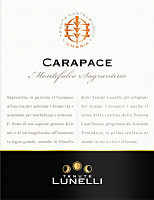
|
|
Montefalco Sagrantino Carapace 2009 |
|
| Tenuta Castelbuono (Umbria, Italy) | |
 Sagrantino Sagrantino | |
| Price: € 27.00 | Score: |
 Intense ruby red and nuances of garnet red, little transparency. Intense ruby red and nuances of garnet red, little transparency. Intense, clean, pleasing, refined and elegant, starts with hints of
blackberry, plum and black cherry followed by aromas of violet, blueberry,
vanilla, tobacco, chocolate, cinnamon, licorice, mace and menthol. Intense, clean, pleasing, refined and elegant, starts with hints of
blackberry, plum and black cherry followed by aromas of violet, blueberry,
vanilla, tobacco, chocolate, cinnamon, licorice, mace and menthol.
 Tannic attack and however balanced by alcohol, full body, intense
flavors, agreeable. Tannic attack and however balanced by alcohol, full body, intense
flavors, agreeable.
 Persistent finish with flavors of blackberry, plum and black cherry. Persistent finish with flavors of blackberry, plum and black cherry. 24 months in cask, 12 months in bottle. 24 months in cask, 12 months in bottle. |
|
 Game, Roasted meat, Braised and stewed meat, Hard cheese Game, Roasted meat, Braised and stewed meat, Hard cheese |
|
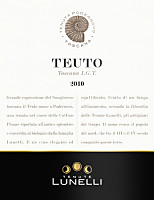
|
|
Teuto 2010 |
|
| Tenuta Podernovo (Tuscany, Italy) | |
 Sangiovese (95%), Merlot (5%) Sangiovese (95%), Merlot (5%) | |
| Price: € 18.00 | Score: |
 Brilliant ruby red and nuances of garnet red, moderate transparency. Brilliant ruby red and nuances of garnet red, moderate transparency. Intense, clean, pleasing and refined, starts with hints of black
cherry, plum and violet followed by aromas of raspberry, blueberry,
tobacco, vanilla, chocolate, cinnamon and menthol. Intense, clean, pleasing and refined, starts with hints of black
cherry, plum and violet followed by aromas of raspberry, blueberry,
tobacco, vanilla, chocolate, cinnamon and menthol.
 Tannic attack and however balanced by alcohol, good body, intense
flavors, pleasing crispness. Tannic attack and however balanced by alcohol, good body, intense
flavors, pleasing crispness.
 Persistent finish with flavors of black cherry, plum and raspberry. Persistent finish with flavors of black cherry, plum and raspberry. 24 months in cask, 12 months in bottle. 24 months in cask, 12 months in bottle. |
|
 Broiled meat and barbecue, Roasted meat, Stewed meat with mushrooms, Hard cheese Broiled meat and barbecue, Roasted meat, Stewed meat with mushrooms, Hard cheese |
|

|
|
Trento Brut Perlé Rosé 2008 |
|
| Ferrari (Trentino, Italy) | |
 Pinot Nero (80%), Chardonnay (20%) Pinot Nero (80%), Chardonnay (20%) | |
| Price: € 32.00 | Score: |
 Intense salmon pink and nuances of salmon pink, moderate transparency,
fine and persistent perlage. Intense salmon pink and nuances of salmon pink, moderate transparency,
fine and persistent perlage.
 Intense, clean, pleasing, refined and elegant, starts with hints of
cherry, raspberry and bread crust followed by aromas of strawberry,
tangerine, cyclamen, rose, yeast, black currant and plum. Intense, clean, pleasing, refined and elegant, starts with hints of
cherry, raspberry and bread crust followed by aromas of strawberry,
tangerine, cyclamen, rose, yeast, black currant and plum.
 Effervescent and crisp attack, however balanced by alcohol, good body,
intense flavors, agreeable. Effervescent and crisp attack, however balanced by alcohol, good body,
intense flavors, agreeable.
 Persistent finish with flavors of cherry, raspberry and strawberry. Persistent finish with flavors of cherry, raspberry and strawberry. Refermented in bottle on its lees for at least 5 years. Refermented in bottle on its lees for at least 5 years. |
|
 Roasted white meat, Roasted fish, Stuffed pasta with meat Roasted white meat, Roasted fish, Stuffed pasta with meat |
|

|
|
Trento Extra Brut Perlé Nero 2007 |
|
| Ferrari (Trentino, Italy) | |
 Pinot Nero Pinot Nero | |
| Price: € 62.00 | Score: |
 Intense straw yellow and nuances of straw yellow, very transparent,
fine and persistent perlage. Intense straw yellow and nuances of straw yellow, very transparent,
fine and persistent perlage.
 Intense, clean, pleasing, refined and elegant, starts with hints of
apple, plum and bread crust followed by aromas of raspberry, yeast,
hazelnut, honey, butter, tangerine, grapefruit, pear and mineral. Intense, clean, pleasing, refined and elegant, starts with hints of
apple, plum and bread crust followed by aromas of raspberry, yeast,
hazelnut, honey, butter, tangerine, grapefruit, pear and mineral.
 Effervescent and crisp attack, however balanced by alcohol, full body,
intense flavors, agreeable. Effervescent and crisp attack, however balanced by alcohol, full body,
intense flavors, agreeable.
 Very persistent finish with long flavors of apple, plum and grapefruit. Very persistent finish with long flavors of apple, plum and grapefruit. Refermented in bottle on its lees for at least 6 years. Refermented in bottle on its lees for at least 6 years. |
|
 Roasted white meat, Roasted fish, Stewed fish, Stuffed pasta Roasted white meat, Roasted fish, Stewed fish, Stuffed pasta |
|
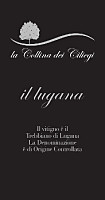
|
|
Lugana Il Lugana 2013 |
|
| La Collina dei Ciliegi (Veneto, Italy) | |
 Trebbiano di Lugana Trebbiano di Lugana | |
| Price: € 14.00 | Score: |
 Pale straw yellow and nuances of greenish yellow, very transparent. Pale straw yellow and nuances of greenish yellow, very transparent. Intense, clean, pleasing and refined, starts with hints of apple, plum
and hawthorn followed by aromas of pear, broom, almond, peach, pineapple
and citrus fruits. Intense, clean, pleasing and refined, starts with hints of apple, plum
and hawthorn followed by aromas of pear, broom, almond, peach, pineapple
and citrus fruits.
 Crisp attack and however balanced by alcohol, good body, intense
flavors, agreeable. Crisp attack and however balanced by alcohol, good body, intense
flavors, agreeable.
 Persistent finish with flavors of apple, plum and pear. Persistent finish with flavors of apple, plum and pear. 5 months in steel tanks. 5 months in steel tanks. |
|
 Fried fish, Pasta with fish, Broiled fish and crustaceans, Sauteed white meat Fried fish, Pasta with fish, Broiled fish and crustaceans, Sauteed white meat |
|
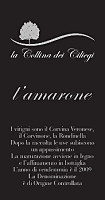
|
|
Amarone della Valpolicella l'Amarone 2010 |
|
| La Collina dei Ciliegi (Veneto, Italy) | |
 Corvina, Corvinone, Rondinella Corvina, Corvinone, Rondinella | |
| Price: € 35.00 | Score: |
 Ruby red color and nuances of garnet red, little transparency. Ruby red color and nuances of garnet red, little transparency. Intense, clean, pleasing and refined, starts with hints of plum,
blackberry and black cherry followed by aromas of violet, blueberry,
vanilla, chocolate, tobacco, mace and menthol. Intense, clean, pleasing and refined, starts with hints of plum,
blackberry and black cherry followed by aromas of violet, blueberry,
vanilla, chocolate, tobacco, mace and menthol.
 Tannic attack and however balanced by alcohol, full body, intense
flavors, pleasing roundness. Tannic attack and however balanced by alcohol, full body, intense
flavors, pleasing roundness.
 Persistent finish with flavors of plum, blackberry and black cherry. Persistent finish with flavors of plum, blackberry and black cherry. 24 months in bottle, 6 months in bottle. 24 months in bottle, 6 months in bottle. |
|
 Game, Roasted meat, Stewed and braised meat, Hard cheese Game, Roasted meat, Stewed and braised meat, Hard cheese |
|
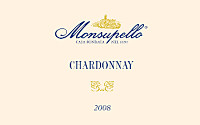
|
|
Chardonnay 2013 |
|
| Monsupello (Lombardy, Italy) | |
 Chardonnay Chardonnay | |
| Price: € 9.00 | Score: |
 Intense straw yellow and nuances of straw yellow, very transparent. Intense straw yellow and nuances of straw yellow, very transparent. Intense, clean, pleasing and refined, starts with hints of apple, plum
and banana followed by aromas of acacia, hawthorn, bread crust, pear,
pineapple and citrus fruits. Intense, clean, pleasing and refined, starts with hints of apple, plum
and banana followed by aromas of acacia, hawthorn, bread crust, pear,
pineapple and citrus fruits.
 Crisp attack and however balanced by alcohol, good body, intense
flavors, agreeable. Crisp attack and however balanced by alcohol, good body, intense
flavors, agreeable.
 Persistent finish with flavors of apple, plum and banana. Persistent finish with flavors of apple, plum and banana. Aged in steel tanks. Aged in steel tanks. |
|
 Pasta with fish, Sauteed fish, Broiled crustaceans, Sauteed white meat Pasta with fish, Sauteed fish, Broiled crustaceans, Sauteed white meat |
|
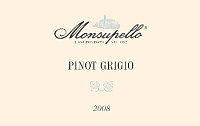
|
|
Pinot Grigio 2013 |
|
| Monsupello (Lombardy, Italy) | |
 Pinot Grigio Pinot Grigio | |
| Price: € 9.00 | Score: |
 Brilliant greenish yellow and nuances of greenish yellow, very
transparent. Brilliant greenish yellow and nuances of greenish yellow, very
transparent.
 Intense, clean, pleasing and refined, starts with hints of apple, pear
and citrus fruits followed by aromas of pear, hawthorn, peach, broom,
hazelnut and chamomile. Intense, clean, pleasing and refined, starts with hints of apple, pear
and citrus fruits followed by aromas of pear, hawthorn, peach, broom,
hazelnut and chamomile.
 Crisp attack and however balanced by alcohol, good body, intense
flavors, agreeable. Crisp attack and however balanced by alcohol, good body, intense
flavors, agreeable.
 Persistent finish with flavors of apple, plum and peach. Persistent finish with flavors of apple, plum and peach. Ages in steel tanks. Ages in steel tanks. |
|
 Pasta and risotto with fish and crustaceans, Sauteed fish, Sauteed white meat, Dairy products Pasta and risotto with fish and crustaceans, Sauteed fish, Sauteed white meat, Dairy products |
|
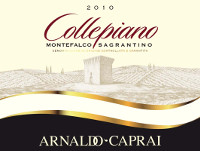
|
|
Montefalco Sagrantino Collepiano 2010 |
|
| Arnaldo Caprai (Umbria, Italy) | |
 Sagrantino Sagrantino | |
| Price: € 27.00 | Score: |
 Deep ruby red and nuances of garnet red, little transparency. Deep ruby red and nuances of garnet red, little transparency. Intense, clean, pleasing, refined and elegant, starts with hints of
blackberry, black cherry and violet followed by aromas of plum, blueberry,
vanilla, tobacco, cinnamon, peony, mace, pink pepper, cinnamon and menthol. Intense, clean, pleasing, refined and elegant, starts with hints of
blackberry, black cherry and violet followed by aromas of plum, blueberry,
vanilla, tobacco, cinnamon, peony, mace, pink pepper, cinnamon and menthol.
 Tannic attack and however balanced by alcohol, full body, intense
flavors, agreeable. Tannic attack and however balanced by alcohol, full body, intense
flavors, agreeable.
 Very persistent finish with long flavors of blackberry, black cherry
and blueberry. Very persistent finish with long flavors of blackberry, black cherry
and blueberry.
 22 months in barrique, 6 months in bottle. 22 months in barrique, 6 months in bottle. |
|
 Game, Roasted meat, Braised and stewed meat, Hard cheese Game, Roasted meat, Braised and stewed meat, Hard cheese |
|
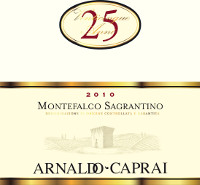
|
|
Montefalco Sagrantino 25 Anni 2010 |
|
| Arnaldo Caprai (Umbria, Italy) | |
 Sagrantino Sagrantino | |
| Price: € 50.00 | Score: |
 Deep ruby red and nuances of garnet red, little transparency. Deep ruby red and nuances of garnet red, little transparency. Intense, clean, pleasing, refined and elegant, starts with hints of
blackberry, black cherry and blueberry followed by aromas of violet, plum,
vanilla, tobacco, peony, chocolate, pink pepper, cinnamon, leather, mace
and menthol. Intense, clean, pleasing, refined and elegant, starts with hints of
blackberry, black cherry and blueberry followed by aromas of violet, plum,
vanilla, tobacco, peony, chocolate, pink pepper, cinnamon, leather, mace
and menthol.
 Tannic attack and however balanced by alcohol, full body, intense
flavors, agreeable. Tannic attack and however balanced by alcohol, full body, intense
flavors, agreeable.
 Very persistent finish with long flavors of blackberry, black cherry
and plum. Very persistent finish with long flavors of blackberry, black cherry
and plum.
 24 months in barrique, 8 months in bottle. 24 months in barrique, 8 months in bottle. |
|
 Game, Roasted meat, Stewed and braised meat, Hard cheese Game, Roasted meat, Stewed and braised meat, Hard cheese |
|
News |
|
In this section are published news and information about events concerning the world of wine and food. Whoever is interested in publishing this kind of information can send us a mail to our address.
|
AquavitaeReview of Grappa, Distillates and Brandy |
|
|
| Distillates are rated according to DiWineTaste's evaluation method. Please see score legend in the "Wines of the Month" section. |
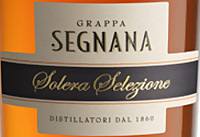
|
|
Grappa Segnana Solera Selezione |
|
| Segnana (Trentino, Italy) | |
 Pomace of Chardonnay and Pinot Noir Pomace of Chardonnay and Pinot Noir | |
| Price: € 26.00 - 70cl | Score: |
 Limpid, intense and brilliant amber color. Limpid, intense and brilliant amber color. Intense, clean, pleasing, refined and elegant with aromas of hazelnut,
dried fig, honey, chocolate, vanilla, peach, tobacco, prune and cigar box
with almost imperceptible alcohol pungency. Intense, clean, pleasing, refined and elegant with aromas of hazelnut,
dried fig, honey, chocolate, vanilla, peach, tobacco, prune and cigar box
with almost imperceptible alcohol pungency.
 Intense flavors with perceptible alcohol pungency which tends to
dissolve rapidly, pleasing roundness, balanced sweetness. Intense flavors with perceptible alcohol pungency which tends to
dissolve rapidly, pleasing roundness, balanced sweetness.
 Very persistent finish with long flavors of chocolate, hazelnut and
prune. Very persistent finish with long flavors of chocolate, hazelnut and
prune.
 Distilled in a batch distiller. Made by assembling five different
vintages and aged in French oak. Distilled in a batch distiller. Made by assembling five different
vintages and aged in French oak.
|
|
Wine Parade |
|
|
| The best 15 wines according to DiWineTaste's readers. To express your best three wines send us an E-mail or fill in the form available at our WEB site. |
| Rank | Wine, Producer | |
|---|---|---|
| 1 |
| Adarmando 2011, Tabarrini |
| 2 |
| Montiano 2011, Falesco |
| 3 |
| Brunello di Montalcino Montosoli 2009, Altesino |
| 4 |
| I Sodi di San Niccolò 2008, Castellare di Castellina |
| 5 |
| Torgiano Rosso Riserva Rubesco Vigna Monticchio 2007, Lungarotti |
| 6 |
| Verdicchio dei Castelli di Jesi Classico Superiore Podium 2010, Garofoli |
| 7 |
| Sagrantino di Montefalco Collepiano 2007, Arnaldo Caprai |
| 8 |
| Pelago 2009, Umani Ronchi |
| 9 |
| Brunello di Montalcino Vigneto Manachiara 2007, Tenute Silvio Nardi |
| 10 |
| Villa Gresti 2006, Tenuta San Leonardo |
| 11 |
| Offida Rosso Il Grifone 2008, Tenuta Cocci Grifoni |
| 12 |
| Amarone della Valpolicella Classico Capitel Monte Olmi 2007, Tedeschi |
| 13 |
| Trento Extra Brut Riserva Lunelli 2006, Ferrari |
| 14 |
| Camartina 2011, Querciabella |
| 15 |
| Collio Ribolla Gialla L'Adelchi 2012, Venica |
| |||||||
Privacy Policy | |||||||


| Copyright © 2002-2024 Antonello Biancalana, DiWineTaste - All rights reserved |
| All rights reserved under international copyright conventions. No part of this publication and of this WEB site may be
reproduced or utilized in any form or by any means, electronic or mechanical, without permission in writing from DiWineTaste. |